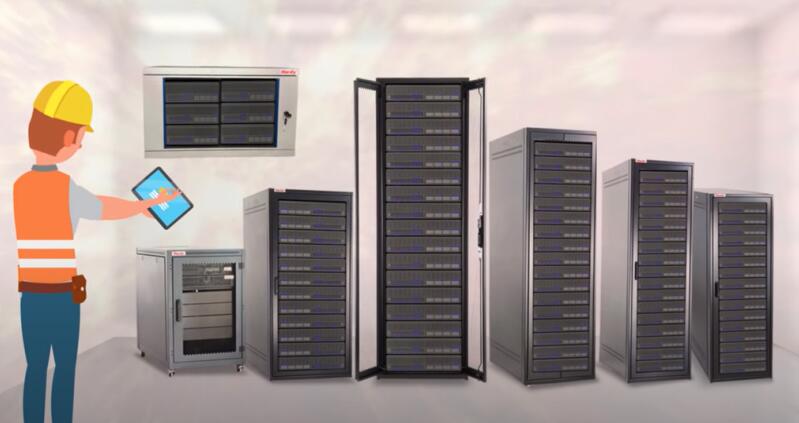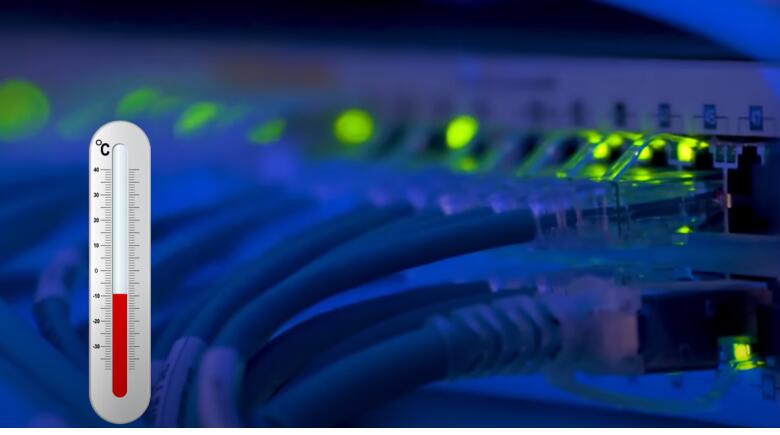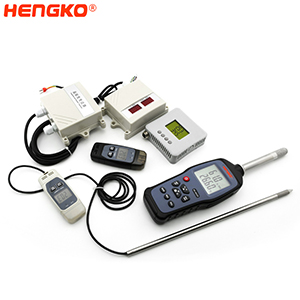
Why we need to Monitor Data Center Temperature and Humidity ?
As we know Data centers contain components such as:
Servers: These are high-powered computers that host websites, apps, databases, and other data. They process and distribute data to other computers.
Also Included Storage systems, Disaster recovery measures and Power systems and other like Cooling System.
Cooling systems: Servers and other hardware can get hot, and if they get too hot, they can malfunction. So, data centers have HVAC systems,
fans, and other equipment to keep the temperature down.
And Here Let's Check Why we need to Monitor Data Center Temperature and Humidity ?
Monitoring temperature and humidity in a data center is crucial due to the following reasons:
1. Preventing Hardware Damage:
High temperature and humidity levels can damage the critical hardware in the data center. Excessive heat can cause components to fail, while extreme humidity conditions, both high and low, can also lead to equipment damage.
2. Maximizing Equipment Lifespan:
Keeping equipment at optimal operating temperatures can extend its lifespan. Overheating can accelerate the wear and tear on virtually all components, effectively reducing their operational life.
3. Maintaining Performance and Uptime:
High heat levels can cause systems to overheat, slowing them down or causing them to shut off unexpectedly. This can lead to downtime, impacting the delivery of critical services and potentially resulting in revenue loss.
4. Energy Efficiency:
By continuously monitoring and managing the temperature and humidity in a data center, it's possible to optimize the use of cooling systems. This can lead to significant energy savings, reducing overall operational costs and promoting sustainability.
5. Compliance with Standards:
There are industry standards and guidelines, such as those from the American Society of Heating, Refrigerating and Air-Conditioning Engineers (ASHRAE), that specify recommended temperature and humidity ranges for data centers. Continuous monitoring ensures compliance with these standards.
6. Disaster Prevention:
By monitoring these environmental conditions, potential issues can be identified and addressed before they become critical. For instance, a rising temperature might indicate a failure in a cooling system, allowing for preventative action to be taken.
7. Data Integrity:
High temperatures and improper humidity levels can lead to increased error rates in hard drives, risking data integrity.
8. Risk Management:
Monitoring provides data that can be used to predict future hardware failure, enabling proactive measures and reducing overall risk.
In summary, monitoring temperature and humidity in a data center is vital for maintaining optimal performance, ensuring the longevity of the equipment, reducing energy costs, and mitigating risks associated with equipment failure and service downtime. It should be a crucial part of any data center's management strategy.
What Temperature and Humidity Can Help You for Data Center Management ?
Temperature and humidity are critical factors in data center management as they directly impact the performance and reliability of the equipment housed in the facility. Maintaining appropriate temperature and humidity levels is essential to ensure the optimal functioning of servers and other sensitive hardware.
Temperature: It is generally recommended to keep the temperature in a data center between 18°C (64°F) and 27°C (80°F). This temperature range helps prevent overheating and reduces the risk of equipment failure. It is important to note that different equipment manufacturers may have specific temperature requirements, so it's advisable to consult their guidelines for precise recommendations.
Humidity: Maintaining proper humidity levels helps prevent static electricity buildup and reduces the risk of electrostatic discharge, which can damage sensitive components. The recommended humidity range for a data center typically falls between 40% and 60%. This range strikes a balance between preventing static discharge and avoiding excessive moisture, which can cause condensation and corrosion.
Monitoring and controlling temperature and humidity levels in a data center are typically done using environmental monitoring systems. These systems provide real-time data on temperature and humidity and allow administrators to take proactive measures to maintain optimal conditions.
By maintaining the right temperature and humidity levels, data center managers can help ensure the reliable operation of critical equipment, prolong the lifespan of hardware, and minimize the risk of costly downtime.
What is the Right You Should to Do for Data Center Management ?
Monitoring the temperature and humidity of the computer room or data center is critical to ensure up time and system reliability. Even companies with 99.9 percent up time lose hundreds of thousands of dollars a year to unplanned outages, according to agencies.
Maintaining recommended temperature and humidity levels in data centers can reduce unplanned downtime caused by environmental conditions and save companies thousands or even millions of dollars each year.
1. Recommended Temperature for Equipment Room
Running expensive IT computer equipment at high temperatures for extended periods of time can significantly reduce component reliability and service life, and can lead to unplanned outages. Maintaining an ambient temperature range of 20 ° C to 24 ° C is the best choice for system reliability.
This temperature range provides a safety buffer for equipment to operate in the event of air conditioning or HVAC equipment failures, while making it easier to maintain safe relative humidity levels.
The widely accepted standard in the computer industry is that expensive IT equipment should not be run in computer rooms or data centers where ambient temperatures exceed 30 ° C. In today's high-density data centers and computer rooms, measuring ambient temperature is often not enough.
Air entering the server can be significantly warmer than room temperature, depending on the layout of the data center and the high concentration of heating equipment such as blade servers. Measuring the temperature of data center aisles at multiple heights can detect potential temperature problems early.
For consistent and reliable temperature monitoring, place a temperature sensor closer to each aisle at least every 25 feet if you are using high temperature devices such as blade servers. It is suggested that a Constant Ge temperature and humidity recorder or temperature and humidity sensor be installed on the top of each rack in the data center for measurement.
The compact temperature and humidity recorder is suitable for the machine room or computing center with narrow space. The product can measure data at specified intervals and store them in integrated data memory. HK-J9A105 USB temperature recorder provides up to 65,000 data stores and data visibility through its electronic paper display for monitoring and inspection. Abnormal alarms can be set, marked assets can be properly saved, emergencies can be timely dealt with, to avoid asset damage or failure caused by temperature overrun and modesty.
2. Recommend the Humidity in the Equipment Room
Relative humidity (RH) is defined as the relationship between the amount of water in the air at a given temperature and the maximum amount of water the air can hold at the same temperature. In a data center or computer room, it is recommended to keep the ambient relative humidity level between 45% and 55% for optimal performance and reliability.
It is particularly important to use industrial high-precision temperature and humidity sensors to monitor data centers. When the relative humidity level is too high, water condensation may occur, leading to hardware corrosion and early system and component failures. If the relative humidity is too low, computer equipment can be susceptible to electrostatic discharge (ESD), which can damage sensitive components. Thanks to HENGKO reliable and long-term stability of humidity sensor technology, high measurement accuracy, transmitter optional signal output, optional display, optional analog output.
When monitoring relative humidity in data centers, we recommend early warning alerts at 40% and 60% relative humidity, and severe alerts at 30% and 70% relative humidity. It is important to remember that relative humidity is directly related to current temperature, so temperature and humidity monitoring is critical. As the value of IT equipment increases, the risks and associated costs multiply.

Types of Temperature and Humidity Sensor can Use for Data Center ?
There are various types of temperature and humidity sensors for your options that can be used in a data center to monitor and control the environmental conditions. Here are a few commonly used sensor types:
1. Thermocouples:
Thermocouples are temperature sensors that measure temperature based on the voltage generated by the junction of two dissimilar metals. They are durable, accurate, and can withstand high temperatures, making them suitable for monitoring hotspots or areas with extreme heat in a data center.
2. Resistance Temperature Detectors (RTDs):
RTDs use the change in electrical resistance of a metal wire or element to measure temperature. They provide high accuracy and stability over a wide temperature range and are often used in critical areas where precise temperature control is required.
3. Thermistors:
Thermistors are temperature sensors that use the change in electrical resistance of a semiconductor material with temperature. They are cost-effective and offer good accuracy. Thermistors are commonly used in environmental monitoring systems for general temperature measurement in data centers.
4. Capacitive Humidity Sensors:
Capacitive humidity sensors measure relative humidity by detecting the change in the dielectric constant of a material due to moisture absorption. They are compact, accurate, and have a fast response time. Capacitive humidity sensors are commonly used in combination with temperature sensors to monitor both temperature and humidity in data centers.
5. Resistive Humidity Sensors:
Resistive humidity sensors measure humidity by using a humidity-sensitive polymer that changes resistance with moisture absorption. They are reliable, cost-effective, and suitable for monitoring humidity levels in data centers.
It's important to choose sensors that are compatible with the monitoring system or infrastructure in the data center. Additionally, regular calibration and maintenance of the sensors are necessary to ensure accurate and reliable measurements.
How to choose Right Temperature and Humidity Sensor for Data Center ?
When choosing the right temperature and humidity sensor for a data center, several factors should be considered to ensure accurate and reliable measurements. Here are some guidelines to help you make an informed decision:
1. Accuracy and Precision:
Look for sensors that offer high accuracy and precision in temperature and humidity measurements. The sensor should have a low margin of error and provide consistent readings over time.
2. Range and Resolution:
Consider the temperature and humidity range required for your data center. Ensure that the sensor's measurement range covers the expected environmental conditions. Additionally, check the resolution of the sensor to ensure it provides the level of detail needed for your monitoring requirements.
3. Compatibility:
Check the compatibility of the sensor with your data center's monitoring system or infrastructure. Ensure that the sensor's output format (analog or digital) is compatible with the data acquisition or control system used in the facility.
4. Response Time:
Evaluate the sensor's response time, especially if you need real-time monitoring of temperature and humidity changes. A faster response time allows for quicker detection of environmental fluctuations and timely corrective actions.
5. Calibration and Maintenance:
Consider the ease of calibration and maintenance of the sensor. Regular calibration ensures accurate readings, so it's important to choose sensors that can be easily calibrated and verified.
6. Durability and Reliability:
Data centers often have demanding environments, so select sensors that are designed to withstand the conditions within the facility. Look for sensors that are robust, resistant to dust or contaminants, and have a long lifespan.
7. Cost:
Consider your budget while balancing the quality and features of the sensor. While cost is a factor, prioritize accuracy and reliability to ensure the protection of your critical equipment.
8. Manufacturer Support:
Choose sensors from reputable manufacturers with a track record of providing reliable products and good customer support. Check for warranties, technical documentation, and available resources for troubleshooting or assistance.
By carefully considering these factors, you can choose a temperature and humidity sensor that meets the specific requirements of your data center and helps ensure optimal environmental conditions for your equipment.
FAQs
1. What is the purpose of temperature and humidity sensors in a data center?
Temperature and humidity sensors are crucial components in data centers as they monitor and control the environmental conditions. These sensors ensure that the temperature remains within the recommended range to prevent equipment overheating and minimize the risk of failures. Humidity sensors help maintain the optimal humidity levels to prevent static electricity buildup and protect sensitive hardware from damage.
2. How do temperature and humidity sensors work?
Temperature sensors, such as thermocouples or RTDs, measure temperature based on the physical properties of the materials they are made of. For example, thermocouples generate a voltage proportional to the temperature difference between their two junctions. Humidity sensors, such as capacitive or resistive sensors, detect changes in electrical properties or dielectric constants of materials in response to moisture absorption.
3. Where should temperature and humidity sensors be installed in a data center?
Temperature and humidity sensors should be strategically placed in various locations within the data center to obtain representative measurements. Key areas for sensor placement include hot and cold aisles, near server racks, and in the vicinity of cooling equipment. It is also recommended to install sensors at different heights and depths to capture variations in environmental conditions.
4. How often should temperature and humidity sensors be calibrated?
Regular calibration of temperature and humidity sensors is essential to maintain accurate measurements. The calibration frequency depends on various factors, including the sensor type, manufacturer's recommendations, and industry standards. It is generally advised to calibrate sensors annually or semi-annually, although more frequent calibration may be required for critical applications or in highly regulated environments.
5. Can temperature and humidity sensors be affected by external factors?
Yes, temperature and humidity sensors can be influenced by external factors such as airflow patterns, proximity to heat sources, and direct sunlight exposure. To minimize such effects, it is crucial to position the sensors away from direct heat sources or airflow disruptions. Shielding the sensors from direct sunlight and ensuring proper sensor installation can help improve measurement accuracy.
6. Can temperature and humidity sensors be integrated with data center management systems?
Yes, temperature and humidity sensors can be integrated with data center management systems. These systems collect and analyze data from multiple sensors and provide real-time monitoring, alerting, and reporting functionalities. Integration allows data center managers to have a centralized view of environmental conditions and make informed decisions based on the collected data.
7. How do I troubleshoot temperature or humidity sensor issues?
When troubleshooting temperature or humidity sensor issues, it is recommended to first check the physical installation of the sensor, ensuring it is properly connected and positioned. Verify that the sensor is receiving power and that the data acquisition system is functioning correctly. If the issue persists, consult the manufacturer's documentation or seek technical support to diagnose and resolve the problem.
8. Are there any industry standards or regulations for temperature and humidity sensors in data centers?
While there are no specific industry-wide standards or regulations solely focused on temperature and humidity sensors in data centers, there are guidelines and best practices available. Organizations such as ASHRAE (American Society of Heating, Refrigerating and Air-Conditioning Engineers) provide recommendations on environmental conditions in data centers, including temperature and humidity ranges.
Interested to our Temperature And Humidity Transmitter or other humidity sensor products, please send inquiry as follow form :
Send your message to us:
Post time: Jun-27-2022





